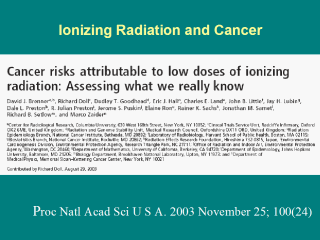| front |1 |2 |3 |4 |5 |6 |7 |8 |9 |10 |11 |12 |13 |14 |15 |16 |17 |18 |19 |20 |21 |22 |23 |24 |25 |26 |27 |28 |29 |30 |31 |32 |33 |34 |35 |36 |37 |38 |39 |40 |review |
 |
Later in his career Sir Richard established
links between ionizing radiation and cancer, which were long suspected by
those in environmental health but until then unproven. In an interview with Professor Sarah Darby, published in Epidemiology in 2003, Sir Richard discusses the importance of his results. SD:At the other end of the spectrum, which do you think has been your most underappreciated paper? RD: My favorite paper is the one with Michael Court Brown deriving the dose-response relationship between radiation and leukemia. It wouldn't be fair to say it has not been appreciated because both the Medical Research Council, which asked us to carry out the study, and a number of other people were very interested in our results and took them seriously. In addition, it was one of the studies that were mentioned by the United Nations when I was awarded the United Nations Award for Cancer Research. But this work is not often remembered nowadays. I doubt if many epidemiologists would pick the dose-response relationship between radiation and leukemia if they were asked to associate particular observations with my work. Yet, it is certainly the second most important piece of work that I have done, after the effects of smoking, and it provided the first suggestive evidence of a linear relationship for the carcinogenic effect of exposure to ionizing radiation down to quite small doses. |